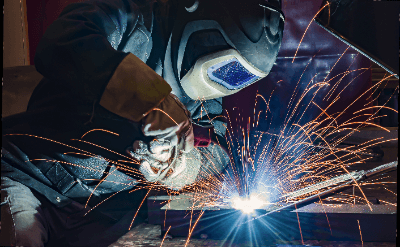What Is an Arc Welder?

An arc welder is a welding machine that uses arc discharge to join two identical metals.
Arc welding occurs when an electric current flows through non-conductive air by passing a high current between unconnected conductors. The current flow creates an excited state that can reach temperatures of 5,000 to 20,000°C (5,000 to 20,000°F). Since iron melts at around 1,500°C, it is possible to create sufficient temperatures to join iron to iron.
There are several types of arc welders, but basically, an electrode or welding rod is used to join base metals. In this process, inert gas is used to prevent oxidation and nitriding.
Uses of Arc Welders
Arc welders are commonly used for metal structures, including automobiles, railroad cars, ships, aircraft, buildings, construction machinery, and industrial machinery. The base metal is often steel, but it can also join non-ferrous metals such as aluminum and titanium.
Welding is performed in an atmosphere with high nitrogen and oxygen levels, so nitriding and oxidation can cause welding defects. To avoid this phenomenon, inert gas that shuts off nitrogen and oxygen is used during arc welding. The inert gas is shielding gas, and argon or carbon dioxide gas is used.
Principles of Arc Welders
Arc welders are broadly classified into consumable-electrode arc welders and non-consumable-electrode arc welders, depending on whether the electrode for discharge is molten. The consumable electrode type includes shielded arc welding and MIG/MAG welding, while the non-consumable electrode type includes TIG welding and plasma welding.
- Shielded Arc Welding Method
This method uses a welding rod with a metal core wire covered with a coating material consisting mainly of calcium carbonate and cellulose to generate an arc discharge. Depending on the power source, AC and DC types are available. The coating material decomposes due to heat, generating shielding gas. This gas protects the welder from oxygen and nitrogen in the atmosphere and prevents welding defects.
- MIG and MAG Welding Methods
MIG/MAG stands for “Metal Inert Gas, Metal Active Gas,” a welding method that uses inert carbon dioxide or argon gas as the shielding gas to prevent oxidation and nitriding.
Welding wire is automatically supplied, resulting in high efficiency. However, it is difficult to weld non-ferrous metals such as aluminum and has the disadvantage that it cannot be used for welding other than ferrous metals.
- TIG Welding Method
TIG stands for “Tungsten Inert Gas” and uses tungsten as the electrode for discharge. Argon gas or helium gas is used as the shielding gas. A welding rod must be prepared separately.
- Plasma Welding Method
This method uses tungsten as the electrode for discharge and a plasma arc as the heat source for welding. Plasma has the advantage of extremely high energy density and minimal deformation of the base metal. On the other hand, the welding machine and running costs are high.
Structure of Arc Welders
Arc welders generate an arc discharge by emitting heat electrons from the electrode. The heat energy generated here melts the base metal to make the joint. Standard arc welders can be classified into two welding power sources: alternating and direct currents.
- AC Arc Welders
Various types of leakage transformers are used in AC arc welders. Among them, the movable iron core type has excellent characteristics. The primary and secondary coils face each other, and the movable iron core is moved to change the reactance against leakage and adjust the secondary current. 2.
- Arc Welders of Direct Current
DC arc welders have an internal mechanism that allows inverter control. Therefore, its internal structure is complicated and has the disadvantages of high prices and poor maintainability. However, they have a wide range of voltage adjustments and can weld at a stable output.
These welding machines are equipped with a welding torch, a device to automatically supply welding rods, and a device to fill and blow out shielding gas.
Other information on Arc Welders
Points to Keep in Mind When Using Arc Welders
The following points should be considered when using commonly used shielded arc welders.
1. Clothing
Clothing should be checked in preparation for welding. Typical clothing includes a work cap or hood, safety glasses, arm covers, leather gloves, a light-shielding protective mask for welding, a front cover, foot covers, and a dust mask.
2. Preparation of Parts
Prepare parts to be used for welding. Welding requires the welder, cabtyre cables, ground clips, welding rod clips, welding rod cable extension joints, power supply tools, and welding rod dryers.
The power tools, etc., should be prepared according to the connection method of the welder and the power source to be connected to. Suppose the connection of the welding machine includes work on a charging circuit. In that case, the Occupational Safety and Health Law requires that the operator receive special training for low-voltage electricity handlers. After the preparation of parts is complete, the tools used for welding are prepared.
Commonly used tools include a Kellen hammer, chipping hammer, wire brush, solid marker, welding gauge, disc grinder, and fire extinguisher. The Occupational Health and Safety Law applies when performing arc welding. It is important to note that it is mandatory to appoint a work supervisor and conduct special health checkups and working environment measurements.